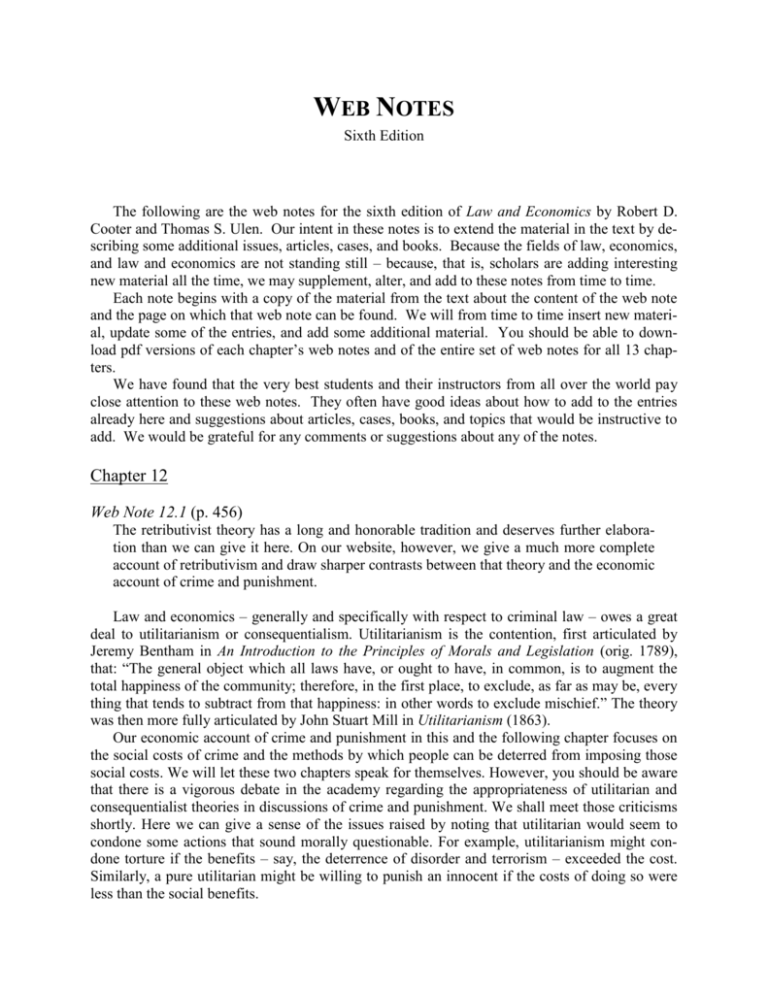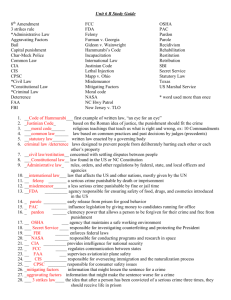Word Version
advertisement

WEB NOTES Sixth Edition The following are the web notes for the sixth edition of Law and Economics by Robert D. Cooter and Thomas S. Ulen. Our intent in these notes is to extend the material in the text by describing some additional issues, articles, cases, and books. Because the fields of law, economics, and law and economics are not standing still – because, that is, scholars are adding interesting new material all the time, we may supplement, alter, and add to these notes from time to time. Each note begins with a copy of the material from the text about the content of the web note and the page on which that web note can be found. We will from time to time insert new material, update some of the entries, and add some additional material. You should be able to download pdf versions of each chapter’s web notes and of the entire set of web notes for all 13 chapters. We have found that the very best students and their instructors from all over the world pay close attention to these web notes. They often have good ideas about how to add to the entries already here and suggestions about articles, cases, books, and topics that would be instructive to add. We would be grateful for any comments or suggestions about any of the notes. Chapter 12 Web Note 12.1 (p. 456) The retributivist theory has a long and honorable tradition and deserves further elaboration than we can give it here. On our website, however, we give a much more complete account of retributivism and draw sharper contrasts between that theory and the economic account of crime and punishment. Law and economics – generally and specifically with respect to criminal law – owes a great deal to utilitarianism or consequentialism. Utilitarianism is the contention, first articulated by Jeremy Bentham in An Introduction to the Principles of Morals and Legislation (orig. 1789), that: “The general object which all laws have, or ought to have, in common, is to augment the total happiness of the community; therefore, in the first place, to exclude, as far as may be, every thing that tends to subtract from that happiness: in other words to exclude mischief.” The theory was then more fully articulated by John Stuart Mill in Utilitarianism (1863). Our economic account of crime and punishment in this and the following chapter focuses on the social costs of crime and the methods by which people can be deterred from imposing those social costs. We will let these two chapters speak for themselves. However, you should be aware that there is a vigorous debate in the academy regarding the appropriateness of utilitarian and consequentialist theories in discussions of crime and punishment. We shall meet those criticisms shortly. Here we can give a sense of the issues raised by noting that utilitarian would seem to condone some actions that sound morally questionable. For example, utilitarianism might condone torture if the benefits – say, the deterrence of disorder and terrorism – exceeded the cost. Similarly, a pure utilitarian might be willing to punish an innocent if the costs of doing so were less than the social benefits. Web Notes – Sixth Edition Cooter & Ulen If you would like to read more on the general philosophical debate regarding utilitarianism and consequentialism, see Amartya Sen & Bernard Williams, Utilitarianism and Beyond (1982); Samuel Scheffler, ed., Consequentialism and Its Critics (1988); and Samuel Scheffler, The Rejection of Consequentialism: A Philosophical Investigation Underlying Rival Moral Conceptions (1984). The theory that challenges the utilitarian-consequentialist theory that we outline is retributivism. Retributivism as the view that punishment is required for and only for those who morally deserve it. They have done something wrong that merits punishment. Professor Michael Moore defines retributivism as follows: “Retributivism is the view that punishment is justified by the moral culpability of those who receive it. A retributivist punishes because, and only because, the offender deserves it. Retributivism thus stands in stark contrast to utilitarian views that justify punishment of past offenses by the greater good of preventing future offenses.” This view began with Immanuel Kant, who held that the moral basis (duty) to punish was so strong “the last murderer on an island society about to disband should be punished despite the lack of any utilitarian reason to do so” (at 79 in Katz et al., which we will cite shortly). A retributivist will not condone torture if it is undeserved (and when is it ever deserved?) and certainly not for consequentialist reasons – save perhaps (and we stress perhaps) when H.L.A. Hart, one of the greatest scholars of jurisprudence, pointed to “the value of the authoritative expression, in the form of punishment, of moral condemnation for the moral wickedness involved in the offence.” (Punishment and Responsibility: Essays in the Philosophy of Law235 (2d ed. 2008).) But Hart also argued that there was not such a sharp distinction between retributivism and consequentialism as others have maintained that there is or ought to be. He suggested that, in practice, most of us follow a mixed theory that combines elements of retributivism and utilitarianism: The sterner forms of retributive theory would regard the moral evil of the offence as justifying a more severe sentence than would be required on deterrent or other Utilitarian grounds: indeed, the point is often made that no greater punishment may be needed to deter a murderer than a robber, yet most systems of punishment show their allegiance to retributive ideas by punishing the murderer more severely. But … many self-styled retributivists treat appropriateness to the crime as setting a maximum within which penalties, judged most likely to prevent the repetition of the crime by the offender or others, are to be chosen. (236-37) Now that we have laid out some important differences between the utilitarian and retributivist theories of crime and punishment, we will deepen the arguments in favor of retributivism and will include the arguments that retributivists typically make against a utilitarian or consequentialist view of crime and punishment. Then we will consider the rejoinders to the retributivists made by three prominent law-and-economics scholars – Judge Richard A. Posner and Professors Louis Kaplow and Steven Shavell. Then we will describe an accommodation between these starkly different theories – an accommodation called a “mixed theory” that combines retributivism and consequentialism. We conclude by looking at recent work by Professors Paul H. Robinson and John M. Darley and by Professors Jonathan Baron and Ilana Ritov that uses some empirical observations to craft a mixed theory with elements of retributivism and consequentialism. We being with a summary of Michael S. Moore, “The Argument for Retributivism,” from Law and Psychiatry: Rethinking the Relationship 238-43 (1984), reprinted in Leo Katz, Michael S. Moore, & Stephen J. Morse, eds., Foundations of Criminal Law (1999). Moore says that utilitarianism holds “that punishment is justified if and only if some net social gain is achieved.” Moore mentions two counterexamples: scapegoating and preventive detention. 2 Web Notes – Sixth Edition Cooter & Ulen With regard to the first, it might be recalled that D.B. Cooper successfully skyjacked an aircraft [in 1971, receiving $200,000 in ransom and parachuting out of the plane into the heavily forested Northwest, never to be found] and that this successful, unsolved crime apparently encouraged the mass of skyjackings that have cost so much in terms of dollars, lives, and convenience. Cooper wore large sunglasses in his escapade, and there was accordingly only a very limited description available of him. Imagine that shortly after his skyjacking we had the benefit of the knowledge we now have by hindsight, and we decided that it would be better to punish someone who looked like Cooper (and who had no good alibi) in order to convince others that skyjacking did not pay. For a consistent utilitarian, there is a net social gain that would be achieved by punishing such an innocent person, and there is no a priori reason that the net social gain in such a case might not outweigh the harm that is achieved by punishing an innocent person. The preventive detention kind of counterexample is very similar. Imagine that a psychiatrist discovers that a patient has extremely dangerous propensities. The patient is also the accused in a criminal trial. It turns out, however, that the accused is not guilty of the crime for which he is charged and in fact has committed no crime whatsoever. Should a judge who, we may suppose, is the only one who knows that the man is both dangerous and innocent find the accused guilty? (At 73 in Katz et al.) Moore suggests that the pure utilitarian or consequentialist would approve finding both the Cooper-substitute and the innocent man in the second example guilty. He also notes (at 74) that a “rule utilitarian” might argue that society “cannot make a general practice of punishing the innocent, because then the harm of so doing (in terms of demoralization costs in society and the like) will outweigh any possible good to be achieved, even the prevention of skyjacking.” Moore also argues against a mixed theory of retributivism and utilitarianism – one that might, for example, seek to get the general deterrence result of punishing the Cooper substitute and yet preserve one’s moral commitment to punish only those who deserve punishment – by pretending to punish the substitute. Professor Moore elaborates on these arguments in “The Moral Worth of Retribution,” in Ferdinand Schoeman, ed. Responsibility, Character, and the Emotions 212 (1987) (reprinted in Katz et al). In that famous essay he argues that the basis of retributivism is not resentment or bloodlust but the very strong guilt that any normal person feels when he or she harms another in an immoral way. He asks how we would feel if we had intentionally committed some awful act, such as murdering another person with a claw hammer? He answers, “My own response, I hope, would be that I would feel guilty unto death. I couldn’t imagine any suffering that could be imposed upon me that would be unfair because it exceeded what I deserved.” (At 86 in Katz et al.) Are there other differences between the two theories? A utilitarian might be in favor of punishing attempts while a retributivist might not. A utilitarian might be in favor of spending money on education to prevent crime (if a connection can be shown to exist) and even engaging in preventive detention if the case for doing so was compelling. How would a retributivist feel about either of those strategies? A utilitarian might be in favor of some rehabilitative expenditures during imprisonment if they would deter future crimes. Would a retributivist? Suppose that someone has hidden his crime very well – consider someone who has loosed a damaging computer virus on the world. A utilitarian might feel that the appropriate punishment for this behavior might be greater than for someone who did not take extensive steps to hide himself. That is, utilitarians might believe that punishment might be scaled up for low-probability-of-detection crimes. Retributivists might not agree. (We will see more on this in the Baron and Ritov article below.) A law-and-economics rejoinder to the retributivist critique might begin with the articulation of the economic theory of criminal law by one of the great founders and expounders of law and 3 Web Notes – Sixth Edition Cooter & Ulen economics – Richard A. Posner, “An Economic Theory of the Criminal Law,” 85 Colum. L. Rev. 1193, 1195 (1985). Here is how he summarizes his contentions in that article: “My analysis can be summarized in the following propositions: 1. The major function of criminal law in a capitalist society is to prevent people from bypassing the system of voluntary, compensated exchange – the ‘market,’ explicit or implicit – in situations where, because transaction costs are low, the market is a more efficient method of allocating resources than forced exchange. Market bypassing in such situations is inefficient – in the sense in which economists equate efficiency with wealth maximization – no matter how much utility it may confer on the offender. 2. Much of this market bypassing cannot be deterred by tort law – that is, by privately enforced damage suits. The optimal damages that would be required for deterrence would so frequently exceed the offender’s ability to pay that public enforcement and nonmonetary sanctions such as imprisonment are required. 3. Such sanctions are extremely costly for a variety of reasons, and this, together with the socially worthless character of most of the sanctioned conduct, has a number of implications for efficient criminal law doctrine, such as that unsuccessful attempts should be punished in order to economize on costlier punishments for completed crimes. The threat of punishing attempts, as we shall see, makes the completed crime more costly in an expected sense and therefore less likely to be committed. I contend that the main differences between substantive criminal law and substantive tort law can be derived from the differences in (1) the social costs of criminal and tort sanctions and (2) the social benefits of the underlying conduct regulated by these two bodies of law. I contend, in short, that most of the distinctive doctrines of the criminal law can be explained as if the objective of that law ere to promote economic efficiency.” In the Web Notes for Chapter 1, we gave attention to an important book by two professors from the Harvard Law School – Louis Kaplow & Steven Shavell, Fairness versus Welfare (2002). Kaplow and Shavell have a section of their work (see pp. pp. 294 – 317) in which they discuss the retributive theory of criminal punishment. Not surprisingly they criticize the retributive theory. They make the following points. First, they find the retributive theory unhelpful in that it “does not include a definition of what constitutes wrongful behavior deserving punishment.” (At 303.) Sure, murder, rape, and a few actions clearly merit punishment. But “why is breaking a contract or a promise about a dinner engagement not deemed to be a wrong deserving punishment (or is it)? Is sex our of marriage a wrong deserving punishment? If failing to stop a crime occurring?” (At 303 – 304.) Second, “even if we are able to identify wrongful acts that deserve punishment, the question then arises of how to assess the degree of wrongfulness.” (At 305.) Should we pay more attention to the nature of the harm (such as when one punches one’s neighbor in the nose) or to the premeditation with which the act was done (such as when one plans to steal one’s neighbor’s morning newspaper)? (At 305.) Third, “how do we determine the proper punishment given a view of the magnitude of the wrong?” (At 306.) There is, Kaplow and Shavell point out, “no natural metric for translating the wrong into the punishment.” If the wrong is pecuniary, then the punishment can be also (but then this sounds very much like a civil wrong. If the wrong is physical, how can that be translated into monetary terms or into community service or a prison sentence? (Under the lex talionis (the “law of retaliation”) the wrong done to the victim is simply visited on the injurer – an “eye 4 Web Notes – Sixth Edition Cooter & Ulen for an eye.” Almost no serious retributivist endorses the lex talionis as the basis for determining the appropriate punishment.) Fourth, even if one can use retributivist concepts to define what is wrongful and to specify the appropriate punishment, what help can retributivism give in the event of errors? “[I]n reality, errors inevitably will be made in punishment: Punishment will sometimes be too high, including when the innocent are mistakenly punished, and punishment will sometimes be inadequate, including when the guilty are acquitted and thus go without punishment. Given that errors will be made, in punishment and that errors can be reduced by the expenditure of social resources to improve the accuracy of the judicial process, the question arises: What level of expenditure is the retributivist willing to make to reduce the rate of error?” The easy cases – spending a dollar to reduce to zero the probability that an innocent person will be executed – present no challenges. But, as Kaplow and Shavell point out, there is nothing in retributivism per se that helps a decision-maker to decide how much to spend to reduce the probability of executing an innocent person. In the same vein, the authors say, it is clear that we do not catch all wrongdoers. (Indeed, as we will see in Chapter 13, the percentage of those who commit crimes who are identified and prosecuted is very small for most crimes.) And that fact raises the important question of how much society ought to spend – how many resources it should devote to – identifying, prosecuting, and punishing more criminal wrongdoers. And again, there is nothing in retributivism to guide this calculation. By implication (and by writing in the pages subsequent to those in which these criticisms are made), Kaplow and Shavell suggest that welfare economics can and does provide answers to these questions that retributivism cannot provide or has not yet provided. Kaplow and Shavell make two final points. They point out that even though retributivists chide utilitarians or consequentialists for contemplating the possibility of punishing the innocent in order to achieve a greater social good, that tradeoff is not as easily dismissed as retributivists would suggest: A world with more wrongful acts would therefore seem to be a less just world, one that the retributivist would not want to exist. But if the retributivist is bothered by the occurrence of wrongful acts, he cannot be indifferent to whether punishment will result in fewer wrongful acts. To illustrate this problem, suppose that if the fair punishment for murder is applied, ten murders will be committed, whereas if a greater and unfair punishment is threatened, none will be. Given that murder is considered by the retributivist to be a wrongful act – that the world in which an act of murder occurs is less just than one in which it does not – it is hard to understand how the retributivist can say that it does not matter in determining whether the supposedly fair punishment is indeed fair that, as a consequence of insisting on fair punishment, ten murders will occur. (At 311 312.) Because they believe that most retributivists do really believe that, as in this example, consequences do matter, Kaplow and Shavell believe (with Hart, above) that there are very few pure retributivists in the world (and very few pure consequentialists, either). Rather, the contend that most thoughtful commentators “espouse mixed views that combine concerns about fairness and concerns about individuals’ well-being. In particular, few writers would argue that the amount of harm that criminals cause and the cost of operating the legal system (police, courts, prisons) are without importance.” (At 314.) It is possible to discern the outlines of an accommodation taking place between the retributivist and utilitarian positions. One sign of that accommodation might be the article by Professors 5 Web Notes – Sixth Edition Cooter & Ulen Robinson and Darley (another of whose works we discuss in the text of Chapter 13) summarized below. Here is the abstract of the article: Paul J. Robinson & John M. Darley, “The Utility of Desert,” 91 Nw. U. L. Rev. 453 (1997). Abstract: “The article takes up the debate between utility and desert as distributive principles for criminal liability and punishment and concludes that a utilitarian analysis that takes account of all costs and benefits will support the distribution of liability and punishment according to desert, or at least according to the principles of desert as perceived by the community. It reaches this conclusion after an examination of a variety of recent social science data. On the one hand, it finds the traditional utilitarian theories of deterrence, incapacitation, and rehabilitation to have little effect in many instances. It finds instead that the real power to gain compliance with society's rules of prescribed conduct lies not in the threat or reality of official criminal sanction, but in the power of the intertwined forces of social and individual moral control. The networks of interpersonal relationships in which people find themselves, the social norms and prohibitions shared among those relationships and transmitted through those social networks, and the internalized representations of those norms and moral precepts are what cause people to obey the law. The law is not irrelevant to these social and personal forces. Criminal law, in particular, plays a central role in creating and maintaining the social consensus necessary for sustaining moral norms. In fact, in a society as diverse as ours, the criminal law may be the only society-wide mechanism that transcends cultural and ethnic differences. Thus, the criminal law's most important real world effect may be its ability to assist in the building, shaping, and maintaining of these norms and moral principles. It can contribute to and harness the compliance-producing power of interpersonal relationships and personal morality. The criminal law can have a second effect in gaining compliance with its commands. If it earns a reputation as a reliable statement of what the community, given sufficient information and time to reflect, would perceive as condemnable, people are more likely to defer to its commands as morally authoritative and as appropriate to follow in those borderline cases where the propriety of certain conduct is unsettled or ambiguous in the mind of the actor. The extent of the criminal law's effectiveness in both these respects - in facilitating and communicating societal consensus on what is and is not condemnable, and in gaining compliance in borderline cases through deference to its moral authority - is to a great extent dependent on the degree of moral credibility that the criminal law has achieved in the minds of the citizens governed by it. Thus, the criminal law's moral credibility is essential to effective crime control, and is enhanced if the distribution of criminal liability is perceived as doing justice, that is, if it assigns liability and punishment in ways that the community perceives as consistent with the community's principles of appropriate liability and punishment. Conversely, the system's moral credibility, and therefore its crime control effectiveness, is undermined by a distribution of liability that deviates from community perceptions of just desert.” Earlier we said that utilitarians and retributivists might feel very differently about whether punishment should be greater for those who sought to hide their crimes or for whom the probability of detection was greater (regardless of their attempts to hide). Here is the abstract and some reading notes on a recent attempt to address that issue: 6 Web Notes – Sixth Edition Cooter & Ulen Jonathan Baron & Ilana Ritov, “The Role of Probability of Detection in Judgments of Punishment,” 1 J. Legal Analysis 553 (2009). Abstract: “In nine experiments—one a questionnaire given to Israeli judges, the rest on the World Wide Web—we examined the effect of probability of detection of an offense on judgments of punishment. When cases differing in probability were separated, we found almost no evidence for attention to probability (as found previously by others). When cases were presented next to each other, however, a substantial minority of subjects took probability into account. Attention to probability was increased in one study by a probe manipulation concerning deterrent effects. We found inconsistent effects of identifying the perpetrator, or of asking subjects to consider policies versus individuals. Some subjects thought that it was unfair to consider probability, but more subjects thought that probability was relevant because of the need for deterrence. We suggest that the failure to consider probability is to some extent an example of the “isolation effect,” in which people do not think much about secondary effects, rather than entirely a result of ideological commitment to a “just deserts” view of punishment.” It was, the authors say, Cesare Beccaria who first argued, in On Crimes and Punishment (1764), that deterrence of future crimes is a justification for punishment. “Bentham recognized that the magnitude of punishment could be increased to compensate for lower probability of punishment, thus maintaining its ability to deter wrongdoing by reducing the overall expected benefit of crime.” 554. They include this quotation from Bentham’s Introduction to the Principles of Morals and Legislation (1789 – 1843): “To enable the value of the punishment to outweigh that of the profit of the offense, it must be increased, in point of magnitude, in proportion as it falls short in point of certainty.” An example of a crime that might have very large adverse consequences but whose perpetrator has a very small likelihood of being detected is the dissemination of a damaging computer virus, particularly one that lies dormant for a long time. 582-83. “Robinson and Darley [“Testing Lay Intuitions of Justice: How and Why?,” 28 Hofstra L. Rev. 61 (2000)] have argued that such satisfaction [that is, the popular satisfaction for retribution] counts as a major benefit of punishment, largely because the deterrent effects of punishment are in fact minor.” 554. “Sunstein, Schkade, and Kahneman [Cass R. Sunstein, David Schkade, & Daniel Kahneman, “Do People Want Optimal Deterrence?,” 29 J. Legal Stud. 237 (2000)] found that manipulation of probability of detection in hypothetical cases about lawsuits had no effect on prospective juror’ judgments of punitive damage awards in lawsuits. … In a second study, Sunstein et al. found that most (but not all) of their subjects in a sample of law students, asked directly about the appropriateness of taking probability into account as a matter of policy, objected to this policy on the ground of unfairness.” 555. In a related study Carlsmith, Darley, and Robinson [Kevin M. Carlsmith, John M. Darley, & Paul H. Robinson, “Why Do We Punish?: Deterrence and Just Deserts as Motives for Punishment,” 83 J. Personality & Soc. Psych. 284 (2002)] “manipulated probability of detection in a completely between-subjects study, in which each subject read a single scenario. Probability had only a very small effect on judgments of punishment, which was found only in subjects who endorsed the idea of deterrence in other questions about their overall views of punishment.” 555. “Note, first, that the law itself might somehow take probability into account even if individuals do not. But, taking our results at face value, we would expect that offenses with low probability of detection would be underdeterred and/or those with probability would be overdeterred. If 7 Web Notes – Sixth Edition Cooter & Ulen this is true, then two different kinds of prescriptive solutions suggest themselves. One is to attempt to increase the attention given to probability. For example, judges could instruct jurors to consider the need to increase penalties when the chance of conviction is so low that potential offenders might be inclined to ignore it.” 585. Web Note 12.2 (p. 483) As we shall see in the following chapter, there are some clear and testable predictions of the economic theory that we have just outlined, and there is a considerable body of empirical work that we shall summarize there. You are no doubt aware that there are alternative theories of the decision to commit a crime. One of the most famous and widely held is what might be called the “socioeconomic” theory. On our website we summarize that theory and give some references to literature regarding it. As we shall see in Chapter 13, there is little empirical evidence of a clear correlation between the business cycle (or its components, such as unemployment or rates of change in GDP) and crime levels (with the interesting exception of auto theft, which is positively correlated with the business cycle). Nonetheless, we may be thinking too narrowly about the connection between socioeconomic variables and crime levels. There is absolutely no question that crime is more common in certain geographic areas and among identifiable groups within society – rather than being randomly distributed geographically or personally. Are there identifiable connections between socioeconomic characteristics of groups and geographic areas and crime? In this Note we will review, first, an important rumination on these matters by a distinguished law professor – Richard H. McAdams of the University of Chicago Law School – and, second, a series of empirical studies of socioeconomic factors and crime by the distinguished sociologist, Rob Sampson of the Department of Sociology, Harvard University. In “Economics Costs of Inequality,” 2010 U. Chi. Legal Forum 23, Professor Richard H. McAdams argues that inequality in income and wealth distributions may be an independent cause of crime. Specifically, he “explore[s] the theory and evidence of two links: that material inequality causes increases in (1) street crimes of property acquisition and (2) crimes constituted by governmental corruption.” (26). As he puts it somewhat later in the paper, the basic claim is that “inequality increases inter-class crime.” (29) McAdams suggests that there are two reasons (beyond those identifiable in Isaac Ehrlich’s work) why one might expect a positive correlation between inequality and crime: First, inequality may dilute the deterrent effect of criminal sanctions. The dominant punishment in many wealthy nations, at least for serious crimes, is prison, yet the deterrent effect of prison depends on the perceived difference between life in prison and life out of prison. In a wealthy nation, prison may work well as a deterrent of the citizen of average wealth because the perceived difference is so great. But in a nation with substantial inequality that foregoes torture and inhumane treatment of prisoners, the poorest citizen may live almost as badly outside of prison as he would inside prison, or at least the gap, and hence the deterrent, is much smaller. In economic terms the costs of prison are lower for the poor. … Another possibility is that inequality adversely affects the level of policing. According to economic theory and empiricism, more policing raises the probability of detecting crime and therefore decrease crime. But the provision of a public good like policing requires collective political action that is most likely when the actors are homogeneous in their demand for the good. 8 Web Notes – Sixth Edition Cooter & Ulen When citizens are instead heterogeneous, differing in the type and quantity of public goods they value, the costs of their political organization is higher and the government will provide less of such goods. (30-31) The implication, McAdams says, is that “other things equal, rising inequality within a city should decrease police funding.” (31) McAdams reports that “the empirical evidence generally supports the claim of the first two theories that inequality increases crime”: In an early economic study, Ehrlich examined crime levels among the states in 1940, 1950, and 1960 and found that ‘[c]rimes against property (robbery, burglary, larceny, and auto theft) … vary positively with the percentage of families below one-half of the median income. [Isaac Ehrlich, “Participation in Illegitimate Activities: An Economic Analysis,” in Gary Becker & William M. Landes, eds., Essays in the Economics of Crime and Punishment 68. 87 (1974).] In 1993, Hsieh and Pugh published a meta-analysis of the literature and found a “significant link between income inequality and violent crime.” [Ching-Chi Hsieh & M.D. Pugh, “Poverty, Income Inequality, and Violent Crime: A Meta-Analysis of Recent Aggregate Data Studies,” 18 Crim. Just. Rev. 182, 198 (1993) (“applying meta-analysis to 34 aggregate data studies reporting 76 zeroorder correlation coefficients for all measures of violent crime with either poverty or income inequality, of which all but two, or 97 percent, were positive and, of those, nearly 80 percent were of at least moderate strength, meaning greater than 0.25”).] But ten years later Rodrigo Reis Soares “reviewed and summarized the [same] literature, finding it more mixed.” [See Soares, “Development, Crime, and Punishment: Accounting for the International Differences in Crime Rates,” 73 J. Dev. Econ. 155 (2004).] (McAdams’ footnote 31 on p. 33 contains references to and brief summaries of 14 empirical studies of the relationship between income inequality and crime.) McAdams also recommends the econometric sophistication of a study by Pablo Fajnzylber, Daniel Lederman, & Norman Loayaza, “Inequality and Violent Crime,” 45 J. Law & Econ. 1 (2002): They reported on panel data consisting of five-year averages for homicides in 39 countries during 1965-95 and for robberies in 37 countries during 1970-94. Across and within countries, they studied the correlation between inequality as defined by various measures and crime, measured by robbery and homicide, while controlling for other influences on the crime rate and various forms of measurement error. They concluded that ‘[c]rime rates and inequality are positively correlated (within each country and, particularly, between countries), and it appears that this correlation reflects causation from inequality to crime rates, even controlling for other crime determinants.’ (at 26) Specifically, they found that if the Gini index ‘falls permanently by the within-country standard deviation in the sample (about 2.4 percentage points), the intentional homicide rate will decrease by 3.7 percent in the short run and 20 percent in the long run.’ (at 17). They also found that ‘a decline of 1 within-country standard deviation in theGini coefficient (about 2.1 percent) leads to a 6.5 percent decline of the robbery rate in the short run and a 23.2 percent decline in the long run.’ (1t 18) (35-36) More recently, Eric Neumayer has criticized the Fajnzylber, Lederman, and Loayaza study. He claims that their results vanish if the sample is increased to a include 59 countries. [Eric Neumayer, “Inequality and Violent Crime: Evidence from Data on Robbery and Violent Theft,” 42 J. Peace Res. 101 (2005).] McAdams concludes, however, that the “overall results favor the inequality-crime link.” In particular, he reports that several new studies “focus specifically on the regional variation of 9 Web Notes – Sixth Edition Cooter & Ulen crime and inequality in the United States and find a strong positive relationship.” (36, citing Edward L. Glaeser, Matthew G. Resseger, & Kristina Tobio, “Urban Inequality,” NBER Working Paper 14419 (2008).] Professor Rob Sampson of the Department of Sociology, Harvard University, has been one of the leading students of sociological factors and crime. Here are the abstracts and brief notes on several of his most notable studies: Robert J. Sampson & John H. Laub, “Crime and Deviance Over the Life Course: The Salience of Adult Social Bonds,” 55 Am. Sociol. Rev. 609 (1990). Abstract: Analyzing the natural histories of two samples of boys that differ dramatically in childhood delinquency, we test a model of crime and deviance over the life course. The first hypothesis is that childhood antisocial behavior predicts problems in adult development across a wide variety of dimensions. Second, we argue that social bonds in adulthood – to work and family – explain changes in crime and deviance over the life span. The longitudinal data were reconstructed from the Gluecks’ classic study of delinquent and non-delinquent makes from childhood to age 32. [Sheldon and Eleanor Glueck, Unraveling Juvenile Delinquency (1950) and Delinquents and Nondelinquents in Perspective (1968).] Childhood delinquency is linked to adult crime, alcohol abuse, general deviance, economic dependency, educational failure, unemployment, divorce, and even charges in the military. Despite this continuity, job stability and strong marital attachment in adulthood inhibit adult criminal and deviant behavior. The results support a model of informal social control that recognizes both stability and change in antisocial behavior over the life course.” Robert J. Sampson, Stephen W. Raudenbush & Felton Earls,” Neighborhoods and Violent Crime: A Multilevel Study of Collective Efficacy,” 277 Science 918 (1997). Abstract: “It is hypothesized that collective efficacy, defined as social cohesion among neighbors combined with their wiliness to intervene on behalf of the common good, is linked to reduced violence. This hypothesis was tested on a 1995 survey of 8782 residents of 343 neighborhoods in Chicago, Illinois. Multilevel analyses showed that a measure of collective efficacy yields a high between-neighborhood reliability and is negatively associated with variations in violence, when individual-level characteristics, measurement error, and prior violence are controlled. Associations of concentrated disadvantage and residential instability with violence are largely mediated by collective efficacy.” “Violence has been associated with the low socioeconomic status (SES) and residential instability of neighborhoods. … Our basic premise is that social and organizational characteristics of neighborhoods explain variations in crime rates that are not solely attributable to the aggregated demographic characteristics of individuals.” 918. “A high rate of residential mobility, especially in areas of decreasing population, fosters institutional disruption and weakened social controls over collective life. A major reason is that the formation of social ties takes time. Financial investment also provides homeowners with a vested interest in supporting the commonweal of neighborhood life. We thus hypothesize that residential tenure and homeownership promote collective efforts to maintain social control.” 919. 10 Web Notes – Sixth Edition Cooter & Ulen “Together, three dimensions of neighborhood stratification – concentrated disadvantage, immigration concentration, and residential stability – explained 70 percent of the neighborhood variation in collective efficacy.” 923. Jeffrey D. Morenoff, Robert J. Sampson, Stephen W. Raudenbush, “Neighborhood Inequality, Collective Efficacy, and the Spatial Dynamics of Urban Violence,” 39 Criminology 517 (2001). Abstract: “Highlighting resource inequality, social processes, and spatial interdependence, this study combines structural characteristics from the 1990 census with a survey of 8872 Chicago residents in 1995 to predict homicide variations in 1996-1998 across 343 neighborhoods. Spatial proximity to homicide is strongly related to increased homicide rates, adjusting for internal neighborhood characteristics and prior homicide. Concentrated disadvantage and low collective efficacy – defined as the linkage of social control and cohesion – also independently predict increased homicide. Local organizations, voluntary associations, and friend / kinship networks appear to be important only insofar as they promote the collective efficacy of residents in achieving social control and cohesion. Spatial dynamics couple with neighborhood inequalities in social and economic capacity are therefore consequential for explaining urban violence.” We are very grateful to Richard McAdams and Anna-Maria Marshall for their help with this Web Note. 11








